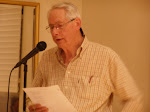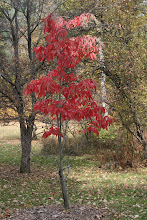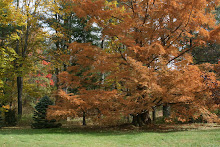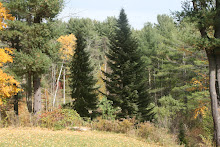 Eastern White Pine (Pinus strobus) an evergreen of straight-grained soft wood with little resin. The tree is most prominent on our arboretum landscape. They can live upwards of 450 years but none of our specimens approach that age. Unlike so many imported species we have here, the Eastern White Pines are native, what I call volunteers, and the north section of the arboretum is a natural forest area of approximately five acres with numerous 90-100 year-old trees forming an impressive overstory. Underneath is found a forest floor environment which suits many other native plants, scrubs and second growth trees. Contrast the neat even rows of a pine tree plantation with the multi-trunked organic forms of the pines of our Natural Forest Area. Common names for these trees are northern white pine, soft pine and Weymouth pine. They range through-out eastern North America from Ontario, around the whole Great Lakes and down the Appalachian mountain range to northern Georgia. A variety grows in the mountains of southern Mexico and Guatemala. White pine is now naturalizing along the mountain slopes of the Czech Republic and southern Poland.
Eastern White Pine (Pinus strobus) an evergreen of straight-grained soft wood with little resin. The tree is most prominent on our arboretum landscape. They can live upwards of 450 years but none of our specimens approach that age. Unlike so many imported species we have here, the Eastern White Pines are native, what I call volunteers, and the north section of the arboretum is a natural forest area of approximately five acres with numerous 90-100 year-old trees forming an impressive overstory. Underneath is found a forest floor environment which suits many other native plants, scrubs and second growth trees. Contrast the neat even rows of a pine tree plantation with the multi-trunked organic forms of the pines of our Natural Forest Area. Common names for these trees are northern white pine, soft pine and Weymouth pine. They range through-out eastern North America from Ontario, around the whole Great Lakes and down the Appalachian mountain range to northern Georgia. A variety grows in the mountains of southern Mexico and Guatemala. White pine is now naturalizing along the mountain slopes of the Czech Republic and southern Poland. The Weymouth pine name for our native (I better say American) tree is an interesting story. The large straight trees that greeted the European settlers were considered "vital" military and commerical resources to the English Government. They were used as masts and keel of sailing ships. In 1620, Captain Weymouth planted the white pine species in England without success. The white pine blister rust disease did not allow their usable growth. E
 ngland by necessity remained dependent on our native trees. Forests of white pines were declared to be "Kingtrees" and even individual trees were selected with the "broad arrow" axe mark reserving them for the British Royal Navy. This reserving of the best trees fed into the growing resentment of American settlers of their Colonial status. The first flag of the American Revolutionary War had a white pine emblem. During the actual war period the patriots use to challenge each other to see how many Kingtrees a single man could axe and haul.
ngland by necessity remained dependent on our native trees. Forests of white pines were declared to be "Kingtrees" and even individual trees were selected with the "broad arrow" axe mark reserving them for the British Royal Navy. This reserving of the best trees fed into the growing resentment of American settlers of their Colonial status. The first flag of the American Revolutionary War had a white pine emblem. During the actual war period the patriots use to challenge each other to see how many Kingtrees a single man could axe and haul. The white pine has an older sacred history as the Great Tree of Peace for the Haudenosaunne. These native peoples include those who lived in the region where Pine Hollow Arboretum now exists. Legend has it that the Haudenosaunne were living in a dark violent period with war among their five nations. A messager of peace was sent by the creator to bring a way for people to find a Great Law of Peace. The East
 ern White Pine became known as The Great Tree of Peace. It was a symbol because being very tall it could be seen from afar. Needles were in clusters of five like the five nations bound together as one. The needles stayed green. Even as seasons change the tree stays green and so shall the Great Peace stay. The white pine was uprooted and into the hole made by the roots were cast down weapons. Buried were greed, hate and jealousy. The tree was placed up again and as tree roots spread in all four directions so was the Great Law of Peace to be spread. On top of the tree sits an eagle. The eagle a watcher to warn of any approaching danger.
ern White Pine became known as The Great Tree of Peace. It was a symbol because being very tall it could be seen from afar. Needles were in clusters of five like the five nations bound together as one. The needles stayed green. Even as seasons change the tree stays green and so shall the Great Peace stay. The white pine was uprooted and into the hole made by the roots were cast down weapons. Buried were greed, hate and jealousy. The tree was placed up again and as tree roots spread in all four directions so was the Great Law of Peace to be spread. On top of the tree sits an eagle. The eagle a watcher to warn of any approaching danger.I thought the white pine forest here might have been a product of the wave of Conservation Corps seedling tree plantings which were prevalent in New York State in the 1920s-1940s. Not so, according to John Abbuhl. He told me they are first growth, natural seeded in abandoned farm fields. There are a few white pines found in different border areas of the arboretum that are a bit older, from 100 to 120 years old. White pine are scattered through-out the arboretum and observation shows mixed results based on how wet one finds the soil. When the soil is too wet the white pine grow stunted, size limited. Intermediate wet soil allows large tree growth however these trees get wind thrown in spring. A whole tree will be blown down. You see them lying sideways with the whole root section lifted up and away from the land. The hills and drained land are suited to long term growth. Joh
 n Abbuhl envisions the day when Pine Hollow Arboretum is known as home to a Virgin Forest of White Pine. In talking with John I was surprised to learn a Virgin Forest is defined as one of trees at least 200 years-old. I thought Virgin meant before the coming of the Norman and his sawmill to Albany County and the cutting down of all the big trees to built ships and houses. So John is right, someday there will be a white pine forest here of 200 year-old trees. A baby born this year might see it. Pines grow in open fields, fire areas and where there are landslides and blowdowns. In a deep forest cover there is not enough light for pine seedlings. A White Pine forest is not a climax forest. In tree succession oaks come in under it and in northern environs maples. yellow birch and ash. In the Albany Pine Bush pitchpine is climax because of fire. So imagine you could have a 200 year-old forest of white pine tress that is not a climax forest, that is not permanent, that is going to be replaced.
n Abbuhl envisions the day when Pine Hollow Arboretum is known as home to a Virgin Forest of White Pine. In talking with John I was surprised to learn a Virgin Forest is defined as one of trees at least 200 years-old. I thought Virgin meant before the coming of the Norman and his sawmill to Albany County and the cutting down of all the big trees to built ships and houses. So John is right, someday there will be a white pine forest here of 200 year-old trees. A baby born this year might see it. Pines grow in open fields, fire areas and where there are landslides and blowdowns. In a deep forest cover there is not enough light for pine seedlings. A White Pine forest is not a climax forest. In tree succession oaks come in under it and in northern environs maples. yellow birch and ash. In the Albany Pine Bush pitchpine is climax because of fire. So imagine you could have a 200 year-old forest of white pine tress that is not a climax forest, that is not permanent, that is going to be replaced.---Alan Casline












No comments:
Post a Comment